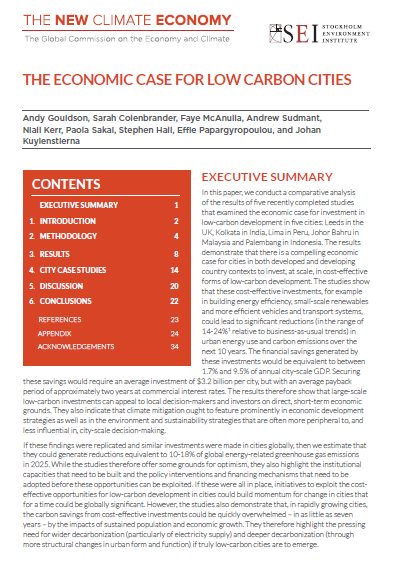The Economic Case for Low-Carbon Cities


This paper conducts a comparative analysis of the results of five studies that examined the economic case for investment in low-carbon development in five cities: Leeds in the UK, Kolkata in India, Lima in Peru, Johor Bahru in Malaysia and Palembang in Indonesia.
This paper conducts a comparative analysis of the results of five studies that examined the economic case for investment in low-carbon development in five cities: Leeds in the UK, Kolkata in India, Lima in Peru, Johor Bahru in Malaysia and Palembang in Indonesia. The results demonstrate that there is a compelling economic case for cities in both developed and developing country contexts to invest at scale iin cost-effective forms of low-carbon development. The studies show that these cost-effective investments, for example in building energy efficiency, small-scale renewables and more efficient vehicles and transport systems, could lead to significant reductions in the range of 14-24%1 relative to business-as-usual trends in the next 10 years. The financial savings generated by these investments would be equivalent to between 1.7% and 9.5% of annual city-scale GDP. Securing these savings would require an average investment of $3.2 billion per city, but with an average payback period of approximately two years at commercial interest rates.
The results show that large-scale low-carbon investments can appeal to local decision-makers and investors on direct, short-term economic grounds. They also indicate that climate mitigation should feature prominently in economic development strategies as well as in the environment and sustainability strategies that are often more peripheral to, and less influential in, city-scale decision-making. If these findings were replicated and similar investments were made in cities globally, then we estimate that they could generate reductions equivalent to 10-18% of global energy-related greenhouse gas emissions in 2025. While the studies offer some grounds for optimism, they also highlight the institutional capacities that need to be built and the policy interventions and financing mechanisms that need to be adopted before these opportunities can be exploited. If these were all in place, initiatives to exploit the cost-effective opportunities for low-carbon development in cities could build momentum for change in cities that for a time could be globally significant. However, the studies also demonstrate that, in rapidly growing cities, the carbon savings from cost-effective investments could be quickly overwhelmed – in as little as seven years – by the impacts of sustained population and economic growth. Therefore, the authors highlight the pressing need for wider decarbonization (particularly of electricity supply) and deeper decarbonization, if truly low-carbon cities are to emerge.